Hello Steemians,
It’s been a long time since I’ve been here with you guys and I’m really glad to be back here with you all.
Today I’ll be going into the construction aspect of engineering which is one interesting aspect of engineering and any civil engineer will testify to that. I took interest in writing on the stabilized soil-cement bricks immediately I got to know about it as a result of the student workshop engineering practise (SWEP) I took part in.
The stabilized soil-cement brick is one great project that will be of great value when it comes to building constructions. I’d like you to be attentive as I take you through the corners of the stabilized soil-cement brick.
We’re going to be looking at the production of stabilised soil-cement bricks using some of the machines produced by “hydraform”
THE RED CLAY BRICKS
Before going into the stabilized soil-cement bricks, it’s important to shed light on the red clay bricks which is the basis of the stabilized soil-cement bricks.
Clay bricks can be classified into two main categories which are the fired bricks and non-fired bricks. Fired bricks are bricks that needs to be fired in a kiln after drying the mould of clay.
The non-fired bricks do not need to be fired in a kiln to get it ready for use and they are known to be long-lasting. It uses lime or concrete materials to get particles of the brick to rigidly bound.
Clay bricks from its name consist of clay, little water to make the clay mixture moist and lime or any other concrete material in the case of non-fired bricks.
The stabilized soil-cement bricks is a type of the non-fired bricks.
THE STABILIZED SOIL-CEMENT BRICKS
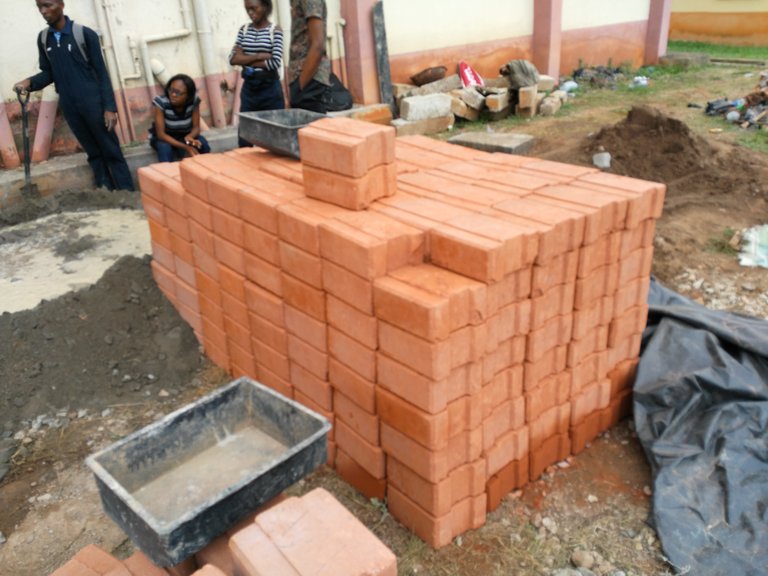
STABILIZED SOIL-CEMENT BRICKS
(Image taken by me @rareghost)
If we are talking of the classification of bricks based on the moulding technique then we can say the stabilized soil-cement bricks is a machine moulded brick.
The stabilized soil-cement brick is moulded in the cavity of a brick moulding machine which moulds the brick by compressing the moist clay cement mixture with a required pressure to get a solid brick. The moist clay mixture is composed of a large amount of clay, 1:10 amount of cement to the clay and a little water just to keep the clay cement mixture moist.
The stabilized soil-cement brick is a type of brick that doesn’t need to be fired in a kiln since it contains cement that will help the rigidity of the brick. The stabilised soil-cement bricks just need to be left to dry for 10-14 days to get a large amount of moisture off the bricks.
The stabilised soil-cement has a great advantage over the normal conventional sand cement blocks we have especially in the western region of Nigeria, West Africa.
THE STAGE TO STAGE MANUFACTURING PROCESS OF THE STABILISED SOIL-CEMENT BRICKS
Based on the practical I had on the making of the stabilized soil-cement bricks, I can outline six stages in the manufacturing of the stabilised soil-cement bricks. The stages are listed below;
- The Hammering Process
- The Sieving Process
- The Measuring Process
- The Mixing Process
- The Moulding Process
- The Drying Process
THE HAMMERING PROCESS
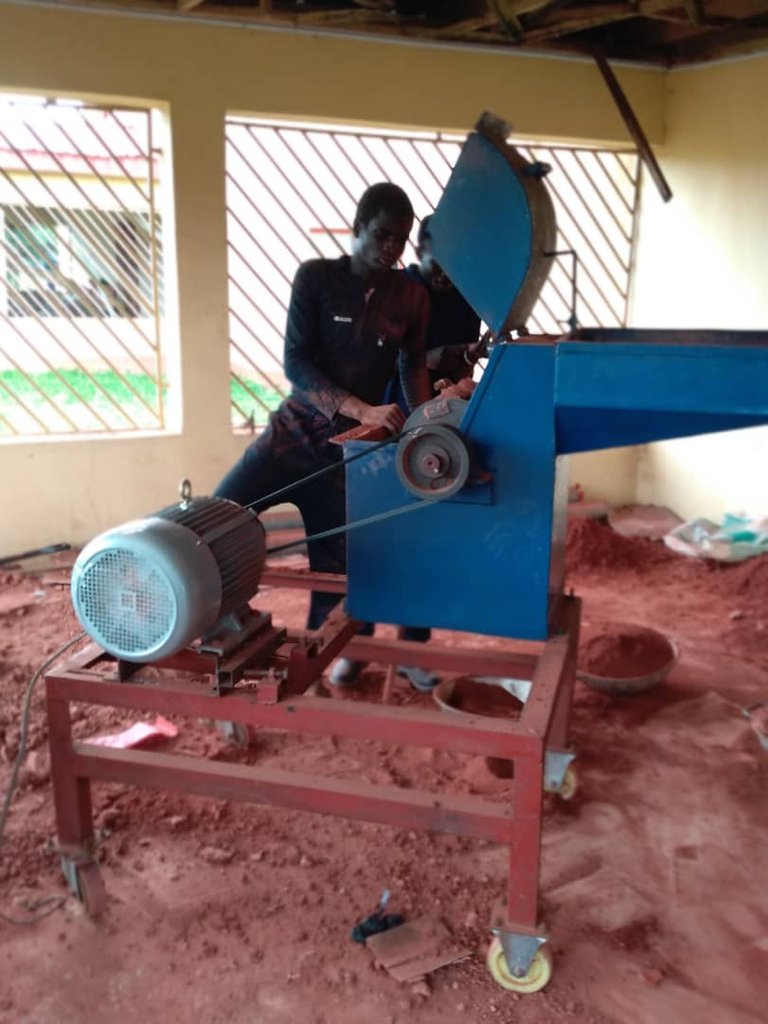
HAMMER CLAY CRUSHER
(Image taken by me @rareghost)
This is the process of hammering hard clay to produce fine clay in order to get a finer texture of clay for the production of the bricks. The hammering process is done with a Hammer Clay Crusher which is a machine that applies the hammering mechanism to produce fine texture clay. The coagulated clay particles are poured into a large opening on the crusher and allowed to grind into fine product so that the end product will pass through an opening at the bottom of the hammer crusher. The end product can now be collected for sieving.
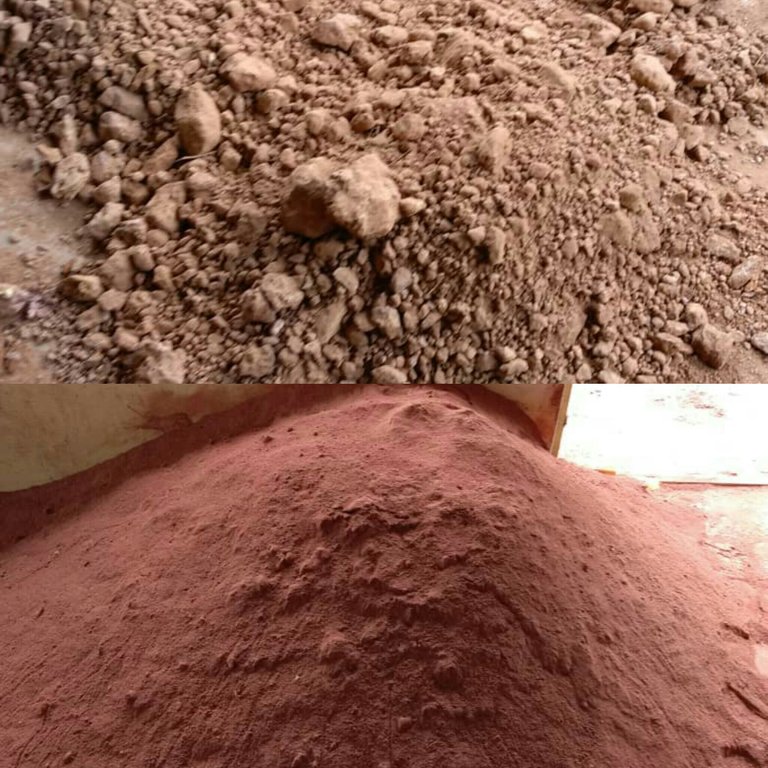 COAGULATED CLAY SAND VS FINE CLAY SAND
(Image taken by me @rareghost)
COAGULATED CLAY SAND VS FINE CLAY SAND
(Image taken by me @rareghost)THE SIEVING PROCESS
This process is done immediately after the hammering process, though some people might choose to skip the process but it is advisable to go through the sieving process. This process is done to get a fine dusty clay that is free from foreign particles and coagulated clay particles. The process can be done using a sieve.
THE MEASURING PROCESS
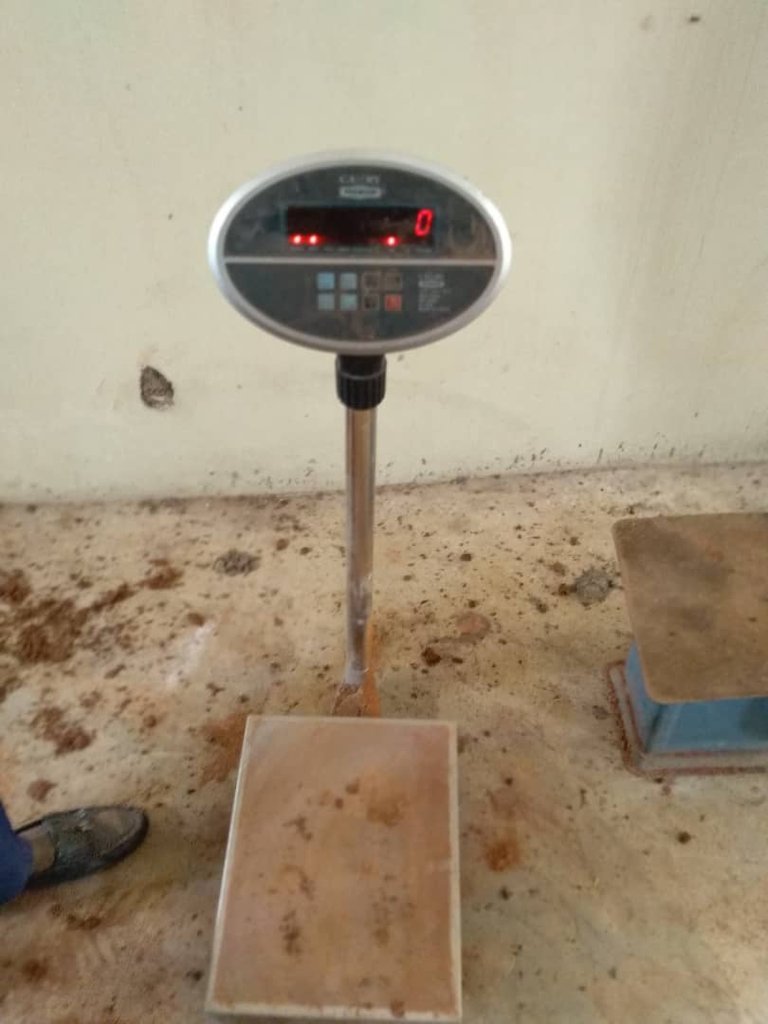
A MEASURING INSTRUMENT
(Image taken by me @rareghost)
This is the next process after the sieving process. In this process, the fine clay is weighed so as to get the right composition before mixing. The cement to be used is also weighed. The weighing of the cement and clay to get an accurate composition can be done using any weighing equipment.
THE MIXING PROCESS

THE PAN MIXER
(Image taken by me @rareghost)
This is the stage where you get to mix the clay with cement and a little amount of water just to keep it moist. The clay-cement composition should be of ratio 10 to 1. For instance for every 60 kg of clay there should be 6 kg of cement for the mixture. The little water enough to make the mixture moist is added.
The mixing process is done in Pan Mixer which is a machine used for mixing purposes. The 60kg weighed clay together with the 6kg cement are poured into the pan and water is added at intervals just to get the mixture to be a little bit moist. The Pan Mixer is allowed to roll in order for it to mix together the clay cement and water.
When the required product is formed the opening at the bottom of the pan mixer is opened to get out the moist clay-cement mixture. The mixture is then transferred to the Interlocking Block Making Machine for the moulding process.
THE MOULDING PROCESS
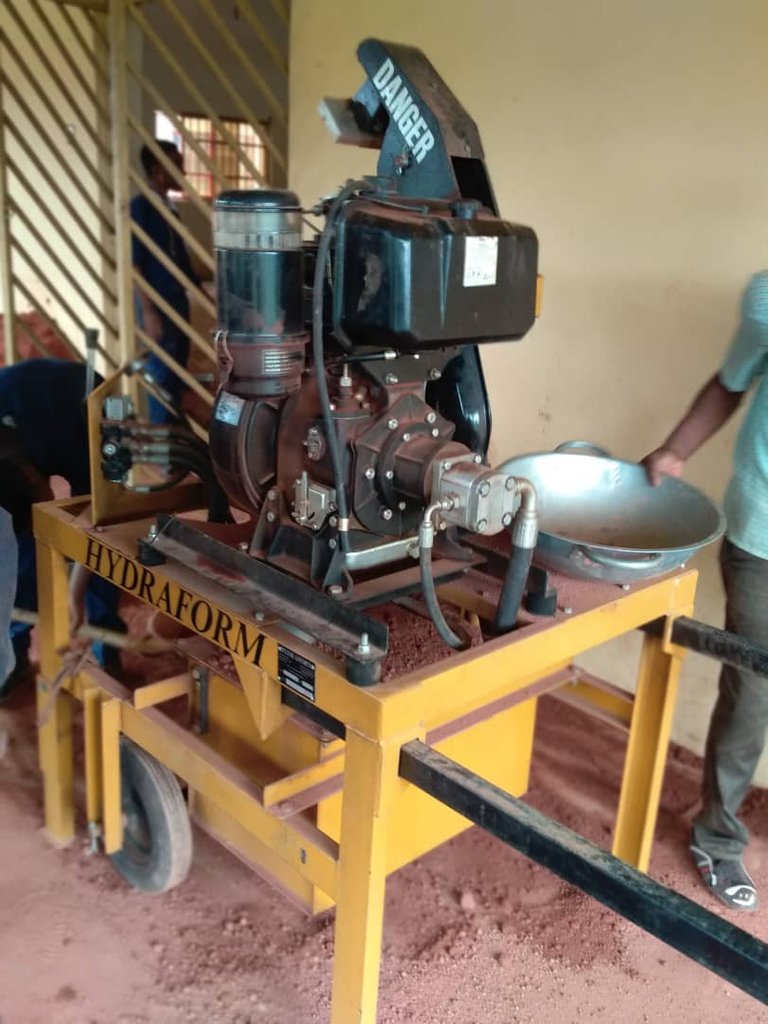
THE INTERLOCKING BLOCK MAKING MACHINE
(Image taken by me @rareghost)
This is the process in which the bricks are moulded. The moulding process is called the machined moulding process because the moulding is done by a machine and not manually. The moist clay-cement mixture is poured into a compartment which makes it easy to get the correct measurement of the mixture needed to mould the brick. The compartment also acts as a drive to move the mixture into the cavity the brick is going to be mould.
The Interlocking Block Making Machine uses the pressure principle to compress the mixture in the cavity to convert it into a solid brick taking the shape of the cavity. The compression is done with the help of a hydraulic system possessed by the machine with the help of some levers. The machine produces a brick at a time. The bricks produced are then transferred for the drying process.
THE DRYING PROCESS

STABILIZED SOIL-CEMENT BRICKS LEFT TO DRY
(Image taken by me @rareghost)
As we have discussed the stabilised soil-cement brick is a form of the non-fired bricks, therefore it wouldn’t be needing any form of firing to get the bricks ready for use.
The bricks produced are left for 10 to 14 days for it to dry so as to get an amount of moisture off the brick for it to be more rigid and ready for usage.
THE GOOD THINGS ABOUT THE STABILIZED SOIL-CEMENT BRICKS
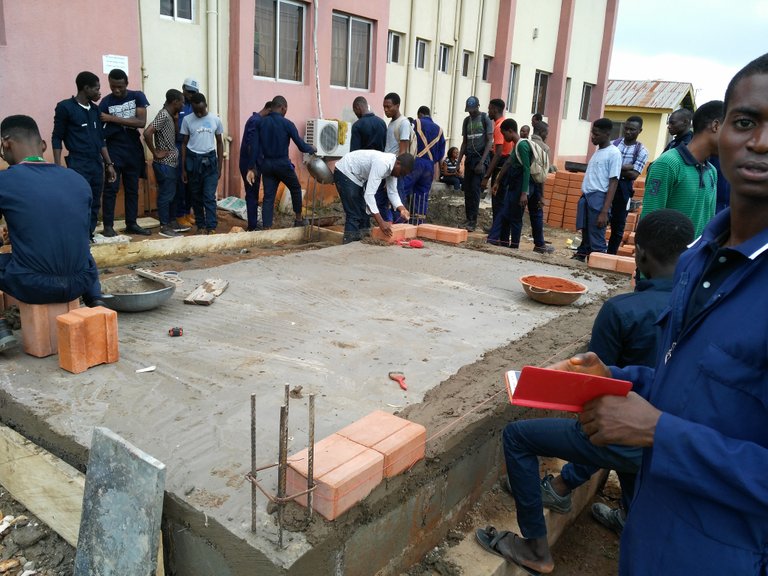
A BUILDING ABOUT TO BE CONSTRUCTED WITH THE STABILIZED SOIL-CEMENT BRICKS.
(Image taken by me @rareghost)
Talking of the advantages of the stabilized soil-cement bricks, we should know that the normal red clay bricks have related advantages with the stabilized soil-cement bricks. One glaring advantage the stabilized soil-cement bricks have over the normal fired clay bricks is that it’s cheaper than the fired clay bricks looking at the cost for the firing process.
Below are some advantages of the stabilized soil-cement bricks;
- Cost Effectiveness
- Maintenance Friendly
- Attractive Appeal
- Fire Resistance
- Thermal Insulation
COST EFFECTIVENESS
The cost of producing the stabilized soil-cement bricks is very low compared to the price required to produce the normal convectional blocks. The cost of cement is limited since the amount of cement required to produce the stabilized soil-cement bricks is very little. Moreover, the cost of getting clay sand is very cheap especially in the western part of Nigeria.
MAINTENANCE FRIENDLY
Any building constructed with the stabilized soil-cement bricks has an advantage over other buildings when it comes to maintenance. The stabilised soil-cement bricks do not at any time need painting and therefore does not need repainting. The red bricks can stay solid for a very long time without needing any form of maintenance.
ATTRACTIVE APPEAL
The red colour of the stabilized soil-cement bricks makes it very attractive and this beautifies the building and nullifies the need of getting paints for the building.
FIRE RESISTANCE
A building constructed with the stabilized soil-cement bricks will have the advantage of resisting fire in the case of fire outbreak. The stabilized soil-cement blocks have the ability to withstand the influence of fire and this function improves the durability of the bricks.
THERMAL INSULATION
It is well known that buildings constructed with the stabilized soil-cement bricks have an advantage which is known as the thermal insulation property. During hot weather the inside of the building will be cool thanks to the ability of the stabilized soil-cement bricks being able to insulate the thermal influence on the building. Also, during the cold weather such building will be warm on the inside.
LIMITATIONS OF USING THE STABILIZED SOIL-CEMENT BRICKS
As we all know, there is nothing with advantage and no disadvantage. The stabilized soil-cement also has some limitations. Some of the limitations are outlined below;
- Large Quantity of Labour
- Misinterpretation of the Concept
- Low Technical Performance
LARGE QUANTITY OF LABOUR
For the production of stabilized soil-cement bricks a lot of labour will be needed due to the stages involved in the production.
MISINTERPRETATION OF THE CONCEPT
Most people get the wrong idea about the brick house, they believe the brick house is owned by the less privileged.
LOW TECHNICAL PERFORMANCE
The stabilized soil-cement bricks have low technical performance when compared to the concrete blocks in the sense that the strength of the concrete block is better than that of the stabilized soil-cement bricks.
CONCLUSION
The stabilized soil-cement brick is a type of brick made by the process of compressing the moist cement-clay mixture in the cavity of an interlocking block making machine. It is known to have a lot of advantages such as the thermal insulation property it possesses amongst other advantages. It is also very cheap as the cost of production is quite low compared to other types of blocks.
REFERENCES
If you write STEM (Science, Technology, Engineering and Mathematics) related posts, consider joining #steemSTEM on steemit chat or discord here. If you are from Nigeria, you may want to include the #stemng tag in your post. You can visit this blog by @stemng for more details.


Awesome and enlightening one we got here. I am sure the civil engineers will appreciate this rundown... I have learnt myself....
Nice work. Keep it work.
Thanks for the nice words. I'm happy you learnt something.
Hmm, you really paid attention during SWEP 😀
Lol, I guess I was very active. Though, some reading helped too.
Remarkable work, man. This is what I call making the most of a stressful and naughty situation. He forgot (or maybe did not) to add the thoroughly tiring process he had to go through.
In Addy, we learnt that these bricks can serve as a good shield for someone that's targeted with bullets. Talk about a low budget bunker.
All the same, great article! 💪
Thanks for the addition. The part of the bullet proof ability hasn't been clear to me judging by the availability of sources to prove how true the fact is. Thanks for your attention.
Are cost and availability the only reason Nigerians do not use bricks in their buildings? How tough are bricks? Can someone build like a five-storey structure with bricks? Interesting article.
Well, the toughness of the bricks cannot be compared to that of the concrete blocks. And for the 5 storey building, yes it should go that high, of course when definitely accompanied with some concrete blocks.
Thanks for going through.
Ok. Thank you.
This post has been voted on by the steemstem curation team and voting trail.
There is more to SteemSTEM than just writing posts, check here for some more tips on being a community member. You can also join our discord here to get to know the rest of the community!
Hi @rareghost!
Your post was upvoted by utopian.io in cooperation with steemstem - supporting knowledge, innovation and technological advancement on the Steem Blockchain.
Contribute to Open Source with utopian.io
Learn how to contribute on our website and join the new open source economy.
Want to chat? Join the Utopian Community on Discord https://discord.gg/h52nFrV
Congratulations @rareghost! You received a personal award!
You can view your badges on your Steem Board and compare to others on the Steem Ranking
Vote for @Steemitboard as a witness to get one more award and increased upvotes!